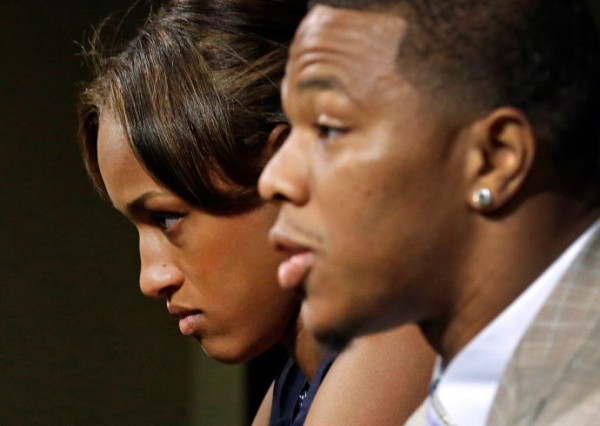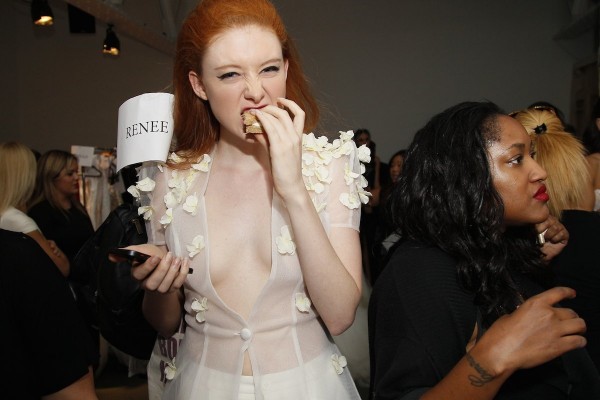Notes
The Focus on Janay Rice: The Pictures are Powerful, but Why are They Necessary?
Visuals matter. As we all learned earlier this week, knocking a woman unconscious is not a fireable offense in the NFL. Getting caught on camera knocking a woman unconscious is. And so, the week’s optics have re-victimized a woman who was already the victim of domestic violence. (Those who are tempted to wonder why she still married him are advised to consult the National Network to End Domestic Violence’s FAQs page, paying special attention to item 1, which states, “a better question is, ‘Why does the abuser choose to abuse?’”). Although speculation abounds regarding exactly what the NFL saw and when they saw it, both the owner and the coaching staff of the Baltimore Ravens and NFL Commissioner Roger Goodell insist that the video that documented Baltimore Ravens running back Ray Rice punching then-fiancée Janay Palmer changed something. What the video did not change were the facts of the case as already known by the NFL and the Ravens organization—something that left the New Yorker’s Amy Davidson asking, “what did people think it looked like when a football player knocked out a much smaller woman? Like a fair fight?”
The image that accompanied Davidson’s New Yorker piece (as well as this Washington Post article and this Guardian column) is reproduced above, and it serves as an apt visual synecdoche of this situation. The photo was taken during the May 2014 press conference in which Ray Rice began by apologizing to literally everyone except his wife and then referred to the attack as “this situation that me and my wife were in.” Janay Rice participated in the press conference by dutifully expressing her deep regret for the “role that I played in the incident that night”—a soundbite that the Ravens organization eagerly tweeted out (the tweet was removed . . . months later and only after the video evidence surfaced).
The tweet, and the lack of public censure it received in the 4 months prior to the video release, is a testament to the persistence of a culture of gendered violence which intimates that women’s actions precipitate the criminal assaults visited upon them. In the still photo from the press conference, Ray Rice looks appropriately earnest (if not adequately contrite) as the image zeroes in on Janay Rice—making the victim, rather than the perpetrator, the focal point of the story. As that image gets recycled in this week’s coverage, viewers are encouraged to ask “why did she stay?” rather than “why did he choose to assault her?” In other words, the perspective of this particular photograph is telling but not surprising.
The question that we should be asking about Janay Rice is, why was she involuntarily forced to trade (what remained of) her privacy for justice? Why was a narrative account of the attack not enough to convince the Ravens, the NFL, and many fans that it was time to stop cheering—and covering—for Ray Rice? The Ravens are offering refunds to fans who purchased team jerseys with Rice’s name and number on them. Why didn’t the fans toss those jerseys out months ago, when we had the full details (but only a partial video record) of the attack? The Guardian’s Hannah Giorgis urged her readers not to watch the TMZ video and then provided an eloquent explanation of why the “broadcasting of victims’ most vulnerable moments as sites for public commentary” is counterproductive, disingenuous, and exploitative. Visuals that train the focus on Janay Rice rather than her husband play into the narrative that Ray Rice and the Ravens worked hard to construct—this is a marital problem rather than a criminal offense. As Giorgis noted, “It is easier to believe that a woman ‘provoked’ catastrophic violence from a supposedly otherwise peaceful man than it is to come to terms with the fact that a well-liked public figure is abusive. It is easier to conceive Palmer as an accomplice in her own beating than it is to realize that almost half of black women killed by their partners were killed as they tried to leave.”
Of course, the assertion that avoiding our collective gaze from horrific or objectionable images is the most appropriate response is becoming a familiar refrain in our image-saturated culture. It’s the new prescription for everything from terrorist violence to opportunistic celebrity privacy violations. We are urged not to look—out of respect. The important part of that equation, however, is not the looking or not looking—it is respect. Both observation and avoidance can be motivated by respect. Both observation and avoidance can facilitate denial. Women’s lives are not story books that require illustration. Yes, the pictures are powerful, but why, in this case, were they necessary?
~ Karrin Anderson
(photo: Patrick Semansky/AP)



Reactions
Comments Powered by Disqus